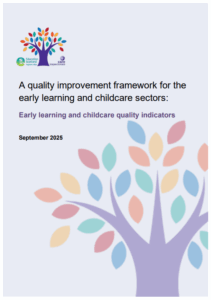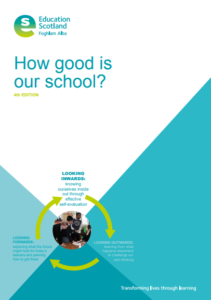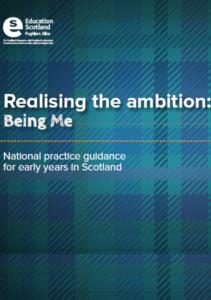Play Pedagogy
– Reflecting on Practice
Leadership And Management of Staff Resources p5 – Self-Evaluation, Quality Assurance and Implementing Change
Leaders ensure that high-quality learning through play is at the heart of improvement planning.
Children Experience High-Quality Spaces p20 – Quality, Safety and Maintenance of Spaces
We recognise the importance of daily outdoor play and the benefits of this for enhancing learning and wellbeing. We support, facilitate and encourage children to explore and build independence. Children are supported to actively explore and learn about the wider world.
Children Experience High Quality Spaces p22 – Children Influence and Affect Change
We have an inclusive environment where children have a belief in their abilities. Carefully selected and well-positioned furniture and resources support all children to make choices and freely play. Resources and materials available to children are varied, adaptive and responsive, catering to children’s individual abilities, needs and interests. We understand the positive impact that rich, multi-sensory play has on children’s learning, resilience and wellbeing.
p25
How can we be confident that our physical environment maximises opportunities for children to be challenged, creative and engaged in their play?
To what extent does the physical environment support different types of play?
How do we know our setting provides a wide range of challenging outdoor play and learning experiences that promote children’s health and wellbeing?
Playing, learning and developing p27 – Children’s engagement
We have a strong understanding of how children develop, learn and progress. Our staff skilfully use relevant theory and practice to support their delivery of high-quality play experiences that excite and engage children as they learn. Children are successful, responsible and confident in their play as a result of the high-quality experiences we offer. They are highly motivated and fully engaged by the range of rich, challenging, planned and responsive experiences both indoors and outdoors.
p31
How do we ensure we keep up to date with relevant theory and demonstrate how our understanding of child development supports high-quality play and learning experiences?
How do we maximise opportunities for children to be challenged, creative and engaged in their play and learning?
Learning, Teaching and Assessment p40 – Interactions to Support Learning
Our highly-skilled staff know when to observe play and interact using well-considered questions, commentary and modelling to support and extend children’s learning. We encourage and support children to be independent learners as they develop, apply and consolidate their skills.
Learning, Teaching and Assessment p41 – Planning and Assessment
Our planning for children’s learning is both responsive and intentional to ensure an appropriate balance of child-led, adult-initiated and adult-directed experiences.
p43
How well does the balance of intentional and responsive planning allow for breadth, depth, challenge and progress across the curriculum? In what ways do children influence planning to take their interests forward?
QI 2.2 p35
Does the curriculum experienced by our learners reflect our rationale? How do we know?
How well are children and young people involved in planning and identifying opportunities for personalisation and choice?
How well do our approaches to profiling develop children’s and young people’s awareness of themselves as learners and support them to recognise the skills for learning, life and work they are developing to inform the planning of future learning?



